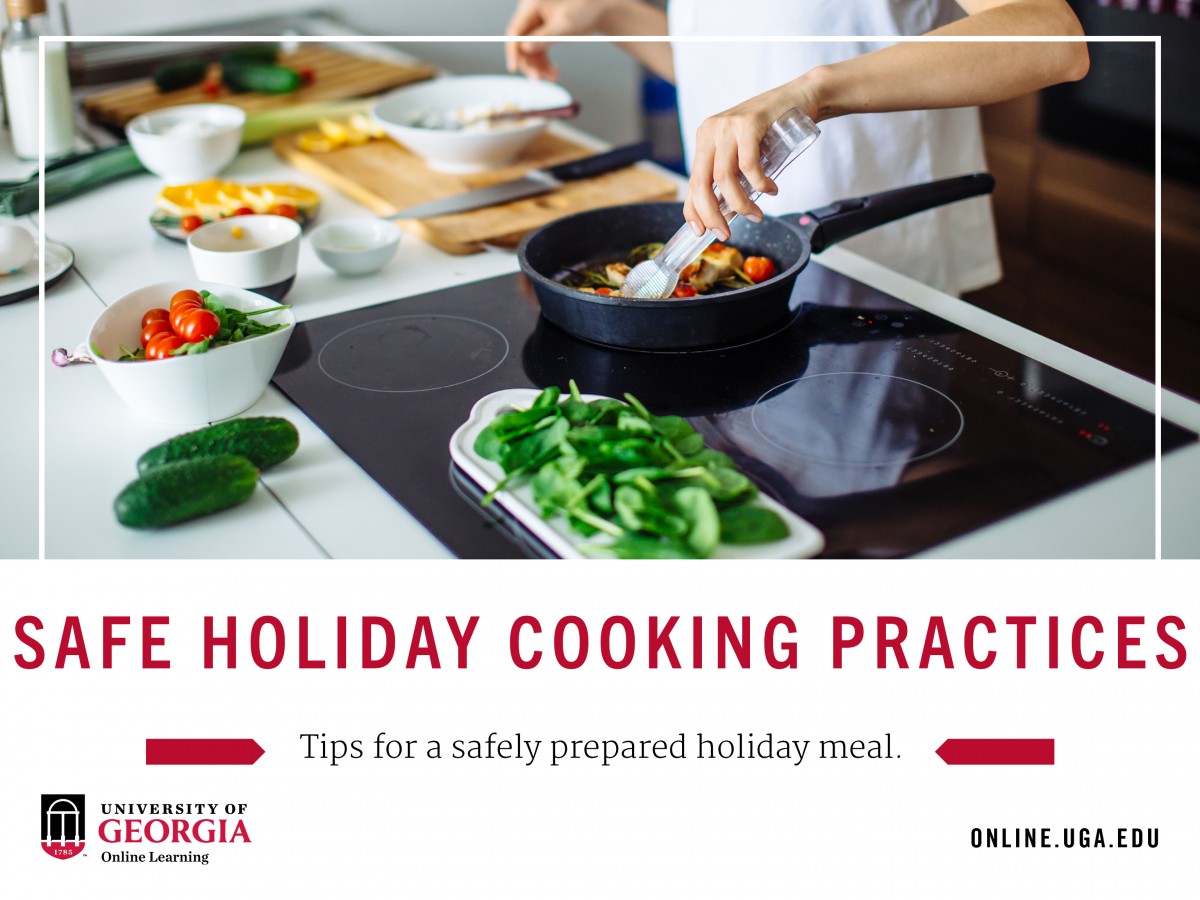Safe Holiday Cooking Practices
Safe Holiday Cooking Practices
The holidays can be an overwhelming, rushed time. You frantically go to the grocery store with a giant shopping list and grab everything you need to feed your entire family. Preparing a large meal for family can feel like a frenzy and safety is sometimes put in the back of your mind. Here are a few tips from University of Georgia online Master of Science in Foods and Nutrition, Community Nutrition professor, Elizabeth Andress, to ensure you have a safe and delicious holiday meals.
According to Andress, when it comes to holiday cooking, “There are definitely safety issues to consider.”

Check equipment
Some of the most serious injuries are caused by faulty or misused equipment, like not using a cutting board when chopping up vegetables. These injuries and instances are preventable, so it is important to always use safety precautions. First, always read and follow the manufacturer’s instructions on your equipment.
Don’t ever use extension cords for cooking appliances because it’ll overload the circuit. For knife safety, make sure to sharpen knives properly and safely. Do not hold food in your hands when cutting food and make sure your food is placed on a non-slip cutting board. Clean the knife often to remove slippery substances such as oil. After use, wash the knives immediately after use. Make sure to put them away and not hidden so you can’t accidentally cut yourself.
On stoves, turn pot handles away from the stove edge so you and no one else can get accidentally burned. For stovetops, always use a backburner when possible to avoid spilling liquid. Do not overfill pots with oil or water and do not use uninsulated pot handles.
Filling pots with too much oil or water may cause the liquid to spill over when the food is placed in the pot. In addition to creating a mess in your kitchen, spillovers at high cooking temperatures can cause severe burns, Andress warns.
Food temperature
Andress urges all chefs, young and old, to keep food safety in the forefront when cooking in the kitchen. One overlooked food safety concern is the temperature of meat.
“You have to be sure all the harmful bacteria have been killed,” she said. “The only way to do this is to measure the temperature of the meat in several places with a food thermometer.” The proper cooking temperatures of poultry, such as chicken or turkey, is 165 degrees fahrenheit, and the cooking temperature of steaks should reach 145 degrees.
It is important to be wary of the expiration dates of foods that you are cooking with. Using expired foods may lead to food poisoning or physical discomfort. Dairy products like milk and cheese expire more quickly than others, so be on the lookout for expiration dates on your food labels.
It is essential that after cooking, your food is stored properly. Bacteria grows rapidly at room temperature, so after food is cooked, keep hot food hot and cold food cold. If you are not eating the prepared food right away, it may be smart to put it in the freezer so that it lasts longer for leftovers.
Safety measures
No matter the occasion, or type of cooking you are doing, Andress recommends following these steps to ensure your safety in the kitchen:
- Never leave hot, cooking food unattended.
- Never allow children or pets near the stove or oven while it’s in use. Even after use, keep children and pets away – the ingredients inside the pot can remain dangerously hot for hours.
- Use well-insulated potholders or oven mitts when touching the pot or lid handles. If possible, wear safety goggles to protect your eyes from liquid splatter.
- Make sure the meat is completely thawed, and be careful with marinades. Oil and water don’t mix, and water causes oil to spill over, which could cause a fire or explosion hazard.
- Keep an all-purpose fire extinguisher nearby. And never use water to extinguish a grease fire. If the fire can’t be managed with an all-purpose fire extinguisher, call 911 for help.
